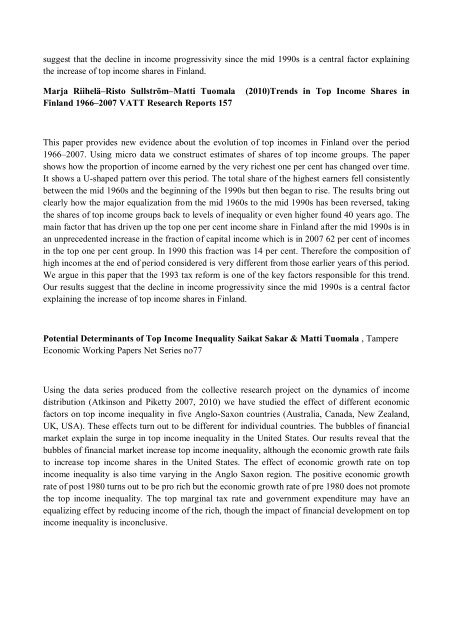Suomen Akatemia VALTA-OHJELMAN HANKKEIDEN TULOKSET
Suomen Akatemia VALTA-OHJELMAN HANKKEIDEN TULOKSET
Suomen Akatemia VALTA-OHJELMAN HANKKEIDEN TULOKSET
You also want an ePaper? Increase the reach of your titles
YUMPU automatically turns print PDFs into web optimized ePapers that Google loves.
suggest that the decline in income progressivity since the mid 1990s is a central factor explaining<br />
the increase of top income shares in Finland.<br />
Marja Riihelä–Risto Sullström–Matti Tuomala (2010)Trends in Top Income Shares in<br />
Finland 1966–2007 VATT Research Reports 157<br />
This paper provides new evidence about the evolution of top incomes in Finland over the period<br />
1966–2007. Using micro data we construct estimates of shares of top income groups. The paper<br />
shows how the proportion of income earned by the very richest one per cent has changed over time.<br />
It shows a U-shaped pattern over this period. The total share of the highest earners fell consistently<br />
between the mid 1960s and the beginning of the 1990s but then began to rise. The results bring out<br />
clearly how the major equalization from the mid 1960s to the mid 1990s has been reversed, taking<br />
the shares of top income groups back to levels of inequality or even higher found 40 years ago. The<br />
main factor that has driven up the top one per cent income share in Finland after the mid 1990s is in<br />
an unprecedented increase in the fraction of capital income which is in 2007 62 per cent of incomes<br />
in the top one per cent group. In 1990 this fraction was 14 per cent. Therefore the composition of<br />
high incomes at the end of period considered is very different from those earlier years of this period.<br />
We argue in this paper that the 1993 tax reform is one of the key factors responsible for this trend.<br />
Our results suggest that the decline in income progressivity since the mid 1990s is a central factor<br />
explaining the increase of top income shares in Finland.<br />
Potential Determinants of Top Income Inequality Saikat Sakar & Matti Tuomala , Tampere<br />
Economic Working Papers Net Series no77<br />
Using the data series produced from the collective research project on the dynamics of income<br />
distribution (Atkinson and Piketty 2007, 2010) we have studied the effect of different economic<br />
factors on top income inequality in five Anglo-Saxon countries (Australia, Canada, New Zealand,<br />
UK, USA). These effects turn out to be different for individual countries. The bubbles of financial<br />
market explain the surge in top income inequality in the United States. Our results reveal that the<br />
bubbles of financial market increase top income inequality, although the economic growth rate fails<br />
to increase top income shares in the United States. The effect of economic growth rate on top<br />
income inequality is also time varying in the Anglo Saxon region. The positive economic growth<br />
rate of post 1980 turns out to be pro rich but the economic growth rate of pre 1980 does not promote<br />
the top income inequality. The top marginal tax rate and government expenditure may have an<br />
equalizing effect by reducing income of the rich, though the impact of financial development on top<br />
income inequality is inconclusive.


